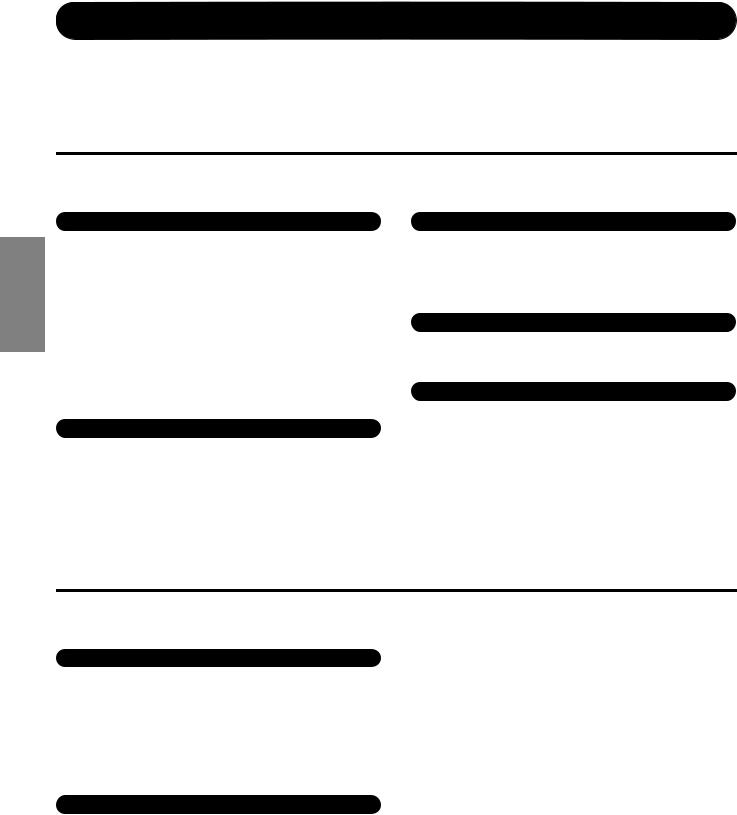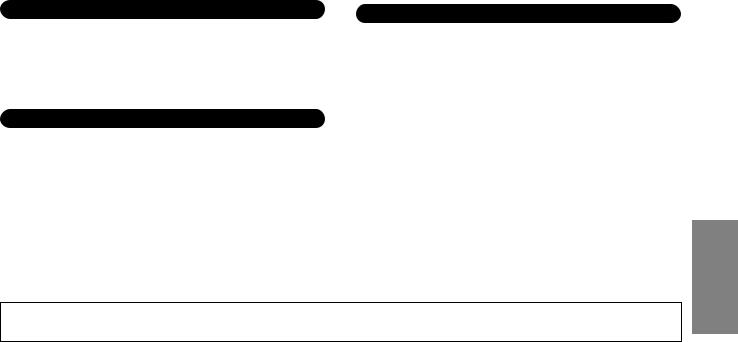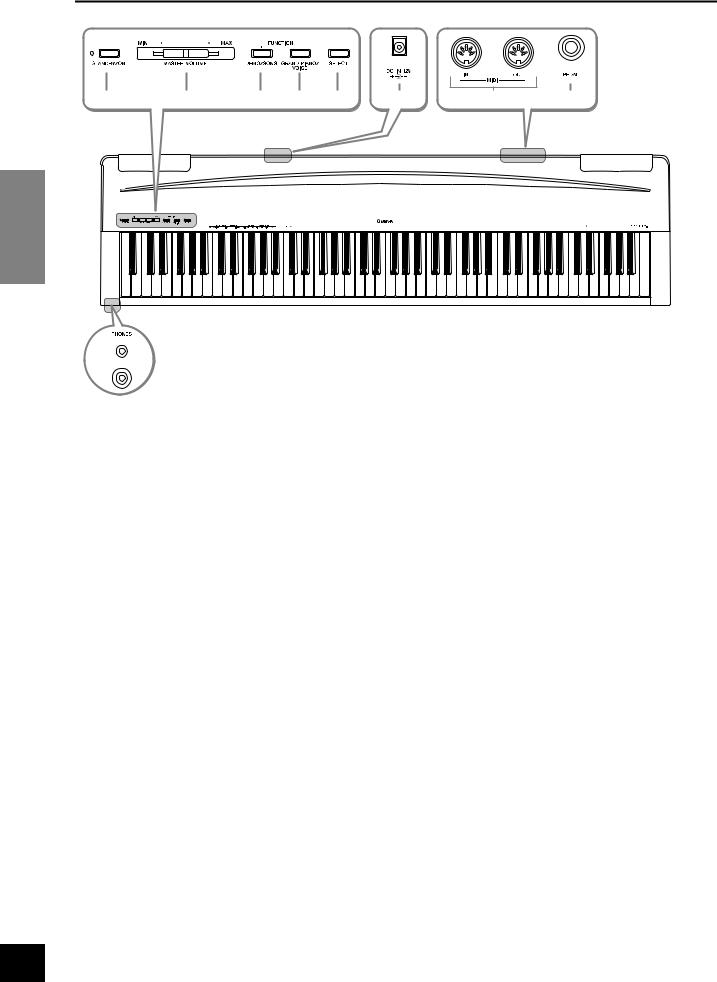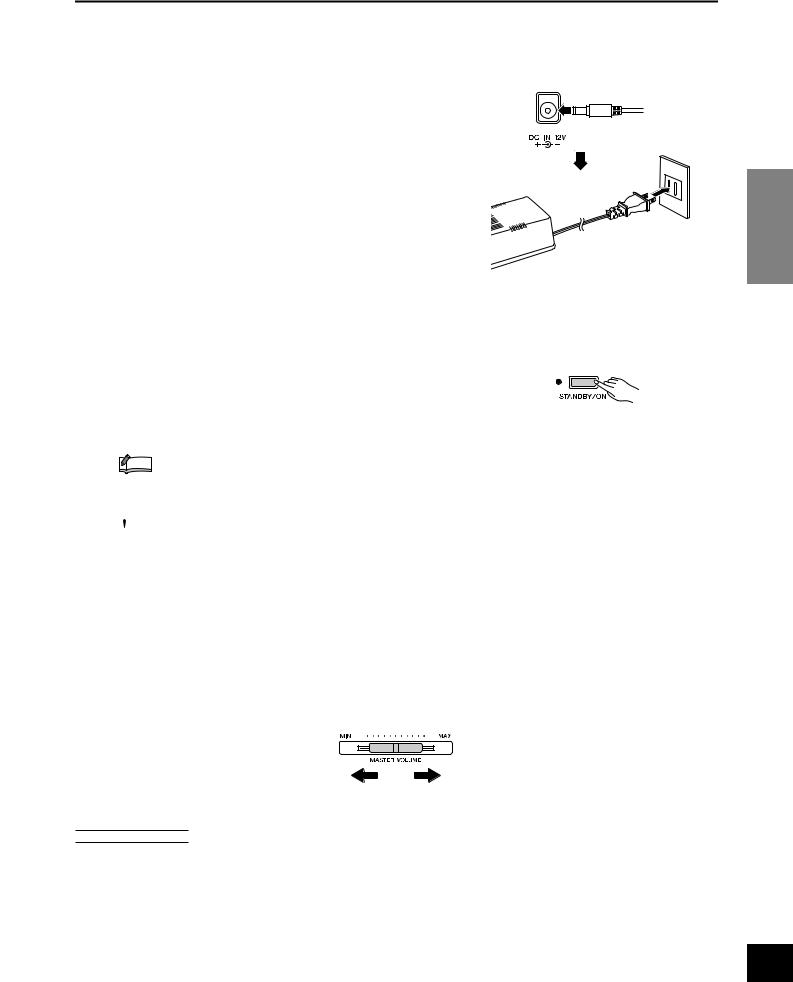Yamaha P70 User Manual

Electronic Piano
P-70/P-70S
Owner’s Manual
Bedienungsanleitung Mode d’emploi
Manual de instrucciones
ENGLISH
DEUTSCH
FRANÇAIS
ESPAÑOL
EN
DE
FR
ES

SPECIAL MESSAGE SECTION
This product utilizes batteries or an external power supply (adapter). DO NOT connect this product to any power supply or adapter other than one described in the manual, on the name plate, or specifically recommended by Yamaha.
WARNING: Do not place this product in a position where anyone could walk on, trip over, or roll anything over power or connecting cords of any kind. The use of an extension cord is not recommended! If you must use an extension cord, the minimum wire size for a 25’ cord (or less) is 18 AWG. NOTE: The smaller the AWG number, the larger the current handling capacity. For longer extension cords, consult a local electrician.
This product should be used only with the components supplied or; a cart, rack, or stand that is recommended by Yamaha. If a cart, etc., is used, please observe all safety markings and instructions that accompany the accessory product.
SPECIFICATIONS SUBJECT TO CHANGE:
The information contained in this manual is believed to be correct at the time of printing. However, Yamaha reserves the right to change or modify any of the specifications without notice or obligation to update existing units.
This product, either alone or in combination with an amplifier and headphones or speaker/s, may be capable of producing sound levels that could cause permanent hearing loss. DO NOT operate for long periods of time at a high volume level or at a level that is uncomfortable. If you experience any hearing loss or ringing in the ears, you should consult an audiologist.
IMPORTANT: The louder the sound, the shorter the time period before damage occurs.
Some Yamaha products may have benches and / or accessory mounting fixtures that are either supplied with the product or as optional accessories. Some of these items are designed to be dealer assembled or installed. Please make sure that benches are stable and any optional fixtures (where applicable) are well secured BEFORE using.
Benches supplied by Yamaha are designed for seating only. No other uses are recommended.
Battery Notice:
This product MAY contain a small non-rechargeable battery which (if applicable) is soldered in place. The average life span of this type of battery is approximately five years. When replacement becomes necessary, contact a qualified service representative to perform the replacement.
This product may also use “household” type batteries. Some of these may be rechargeable. Make sure that the battery being charged is a rechargeable type and that the charger is intended for the battery being charged.
When installing batteries, do not mix batteries with new, or with batteries of a different type. Batteries MUST be installed correctly. Mismatches or incorrect installation may result in overheating and battery case rupture.
Warning:
Do not attempt to disassemble, or incinerate any battery. Keep all batteries away from children. Dispose of used batteries promptly and as regulated by the laws in your area. Note: Check with any retailer of household type batteries in your area for battery disposal information.
Disposal Notice:
Should this product become damaged beyond repair, or for some reason its useful life is considered to be at an end, please observe all local, state, and federal regulations that relate to the disposal of products that contain lead, batteries, plastics, etc. If your dealer is unable to assist you, please contact Yamaha directly.
NAME PLATE LOCATION:
The name plate is located on the bottom of the product. The model number, serial number, power requirements, etc., are located on this plate. You should record the model number, serial number, and the date of purchase in the spaces provided below and retain this manual as a permanent record of your purchase.
NOTICE:
Service charges incurred due to a lack of knowledge relating to how a function or effect works (when the unit is operating as designed) are not covered by the manufacturer’s warranty, and are therefore the owners responsibility. Please study this manual carefully and consult your dealer before requesting service.
Model
Serial No.
ENVIRONMENTAL ISSUES: |
Purchase Date |
Yamaha strives to produce products that are both user safe and environmentally friendly. We sincerely believe that our products and the production methods used to produce them, meet these goals. In keeping with both the letter and the spirit of the law, we want you to be aware of the following:
PLEASE KEEP THIS MANUAL
92-BP (bottom)
2 |
P-70 Owner’s Manual |
|
|

IMPORTANT SAFETY INSTRUCTIONS
INFORMATION RELATING TO PERSONAL INJURY, ELECTRICAL SHOCK, AND FIRE HAZARD POSSIBILITIES HAS BEEN INCLUDED IN THIS LIST.
WARNING- When using any electrical or electronic product, basic precautions should always be followed. These precautions include, but are not limited to, the following:
1.Read all Safety Instructions, Installation Instructions, Special Message Section items, and any Assembly Instructions found in this manual BEFORE making any connections, including connection to the main supply.
2.Main Power Supply Verification: Yamaha products are manufactured specifically for the supply voltage in the area where they are to be sold. If you should move, or if any doubt exists about the supply voltage in your area, please contact your dealer for supply voltage verification and (if applicable) instructions. The required supply voltage is printed on the name plate. For name plate location, please refer to the graphic found in the Special Message Section of this manual.
3.This product may be equipped with a polarized plug (one blade wider than the other). If you are unable to insert the plug into the outlet, turn the plug over and try again. If the problem persists, contact an electrician to have the obsolete outlet replaced. Do NOT defeat the safety purpose of the plug.
4.Some electronic products utilize external power supplies or adapters. Do NOT connect this type of product to any power supply or adapter other than one described in the owners manual, on the name plate, or specifically recommended by Yamaha.
5.WARNING: Do not place this product or any other objects on the power cord or place it in a position where anyone could walk on, trip over, or roll anything over power or connecting cords of any kind. The use of an extension cord is not recommended! If you must use an extension cord, the minimum wire size for a 25’ cord (or less) is 18 AWG. NOTE: The smaller the AWG number, the larger the current handling capacity. For longer extension cords, consult a local electrician.
6.Ventilation: Electronic products, unless specifically designed for enclosed installations, should be placed in locations that do not interfere with proper ventilation. If instructions for enclosed installations are not provided, it must be assumed that unobstructed ventilation is required.
7.Temperature considerations: Electronic products should be installed in locations that do not significantly contribute to their operating temperature. Placement of this product close to heat sources such as; radiators, heat registers and other devices that produce heat should be avoided.
8.This product was NOT designed for use in wet/damp locations and should not be used near water or exposed to rain. Examples of wet/damp locations are; near a swimming pool, spa, tub, sink, or wet basement.
9.This product should be used only with the components supplied or; a cart, rack, or stand that is recommended by the manufacturer. If a cart, rack, or stand is used, please observe all safety markings and instructions that accompany the accessory product.
10.The power supply cord (plug) should be disconnected from the outlet when electronic products are to be left unused for extended periods of time. Cords should also be disconnected when there is a high probability of lightning and/or electrical storm activity.
11.Care should be taken that objects do not fall and liquids are not spilled into the enclosure through any openings that may exist.
12.Electrical/electronic products should be serviced by a qualified service person when:
a.The power supply cord has been damaged; or
b.Objects have fallen, been inserted, or liquids have been spilled into the enclosure through openings; or
c.The product has been exposed to rain: or
d.The product dose not operate, exhibits a marked change in performance; or
e.The product has been dropped, or the enclosure of the product has been damaged.
13.Do not attempt to service this product beyond that described in the user-maintenance instructions. All other servicing should be referred to qualified service personnel.
14.This product, either alone or in combination with an amplifier and headphones or speaker/s, may be capable of producing sound levels that could cause permanent hearing loss. DO NOT operate for a long period of time at a high volume level or at a level that is uncomfortable. If you experience any hearing loss or ringing in the ears, you should consult an audiologist. IMPORTANT: The louder the sound, the shorter the time period before damage occurs.
15.Some Yamaha products may have benches and/or accessory mounting fixtures that are either supplied as a part of the product or as optional accessories. Some of these items are designed to be dealer assembled or installed. Please make sure that benches are stable and any optional fixtures (where applicable) are well secured BEFORE using. Benches supplied by Yamaha are designed for seating only. No other uses are recommended.
PLEASE KEEP THIS MANUAL
92-469-2
P-70 Owner’s Manual |
3 |
|
|

ENGLISH
PRECAUTIONS
PLEASE READ CAREFULLY BEFORE PROCEEDING
* Please keep this manual in a safe place for future reference.
 WARNING
WARNING
Always follow the basic precautions listed below to avoid the possibility of serious injury or even death from electrical shock, short-circuiting, damages, fire or other hazards. These precautions include, but are not limited to, the following:
Power supply/AC power adaptor
•Only use the voltage specified as correct for the instrument. The required voltage is printed on the name plate of the instrument.
•Use the specified adaptor (PA-5D or an equivalent recommended by Yamaha) only. Using the wrong adaptor can result in damage to the instrument or overheating.
•Check the electric plug periodically and remove any dirt or dust which may have accumulated on it.
•Do not place the AC adaptor cord near heat sources such as heaters or radiators, and do not excessively bend or otherwise damage the cord, place heavy objects on it, or place it in a position where anyone could walk on, trip over, or roll anything over it.
Do not open
•Do not open the instrument or attempt to disassemble the internal parts or modify them in any way. The instrument contains no user-serviceable parts. If it should appear to be malfunctioning, discontinue use immediately and have it inspected by qualified Yamaha service personnel.
Water warning
•Do not expose the instrument to rain, use it near water or in damp or wet conditions, or place containers on it containing liquids which might spill into any openings.
•Never insert or remove an electric plug with wet hands.
Fire warning
•Do not put burning items, such as candles, on the unit. A burning item may fall over and cause a fire.
If you notice any abnormality
•If the AC adaptor cord or plug becomes frayed or damaged, or if there is a sudden loss of sound during use of the instrument, or if any unusual smells or smoke should appear to be caused by it, immediately turn off the power switch, disconnect the adaptor plug from the outlet, and have the instrument inspected by qualified Yamaha service personnel.
 CAUTION
CAUTION
Always follow the basic precautions listed below to avoid the possibility of physical injury to you or others, or damage to the instrument or other property. These precautions include, but are not limited to, the following:
Power supply/AC power adaptor
•When removing the electric plug from the instrument or an outlet, always hold the plug itself and not the cord.
•Unplug the AC power adaptor when not using the instrument, or during electrical storms.
•Do not connect the instrument to an electrical outlet using a multiple-connector. Doing so can result in lower sound quality, or possibly cause overheating in the outlet.
•Do not place the instrument in an unstable position where it might accidentally fall over.
•Before moving the instrument, remove all connected adaptor and other cables.
•When setting up the instrument, make sure that the AC outlet you are using is easily accessible. If some trouble or malfunction occurs, immediately turn off the power switch and disconnect the plug from the outlet.
•Use only the stand specified for the instrument. When attaching the stand or rack, use the provided screws only. Failure to do so could cause damage to the internal components or result in the instrument falling over.
Location
•Do not expose the instrument to excessive dust or vibrations, or extreme cold or heat (such as in direct sunlight, near a heater, or in a car during the day) to prevent the possibility of panel disfiguration or damage to the internal components.
•Do not use the instrument in the vicinity of a TV, radio, stereo equipment, mobile phone, or other electric devices. Otherwise, the instrument, TV, or radio may generate noise.
4 |
P-70 Owner’s Manual |
(3)-9 1/2 |
|
|
|

PRECAUTIONS
Connections
•Before connecting the instrument to other electronic components, turn off the power for all components. Before turning the power on or off for all components, set all volume levels to minimum. Also, be sure to set the volumes of all components at their minimum levels and gradually raise the volume controls while playing the instrument to set the desired listening level.
Handling caution
•Do not insert a finger or hand in any gaps on the instrument.
•Never insert or drop paper, metallic, or other objects into the gaps on the panel or keyboard. If this happens, turn off the power immediately and unplug the power cord from the AC outlet. Then have the instrument inspected by qualified Yamaha service personnel.
Maintenance
•When cleaning the instrument, use a soft, dry cloth. Do not use paint thinners, solvents, cleaning fluids, or chemical-impregnated wiping cloths.
•Do not place vinyl, plastic or rubber objects on the instrument, since this might discolor the panel or keyboard.
•Do not rest your weight on, or place heavy objects on the instrument, and do not use excessive force on the buttons, switches or connectors.
•Do not operate the instrument for a long period of time at a high or uncomfortable volume level, since this can cause permanent hearing loss. If you experience any hearing loss or ringing in the ears, consult a physician.
ENGLISH
Yamaha cannot be held responsible for damage caused by improper use or modifications to the instrument, or data that is lost or destroyed.
Always turn the power off when the instrument is not in use.
Even when the instrument turns the power off, electricity is still flowing to the instrument at the minimum level. When you are not using the instrument for a long time, make sure you unplug the AC power adaptor from the wall AC outlet.
(3)-9 2/2 |
P-70 Owner’s Manual |
5 |
|
|
|

ENGLISH
Introduction
Thank you for purchasing the Yamaha Electronic Piano P-70/P-70S! We recommend that you read this manual carefully
so that you can fully take advantage of the advanced and convenient functions of the P-70/P-70S.
We also recommend that you keep this manual in a safe and handy place for future reference.
Main Features
 Graded Hammer Standard Keyboard
Graded Hammer Standard Keyboard
Thanks to our experience as the world’s leading manufacturer of acoustic pianos, we’ve developed a keyboard with action that’s virtually indistinguishable from the real thing. Just as on a traditional acoustic piano, the keys of the lower notes have a heavier touch, while the higher ones are more responsive to lighter playing. The keyboard’s sensitivity can even be adjusted to match your playing style. This Graded Hammer technology also enables the P-70 to provide authentic touch in a lightweight instrument.
 AWM Stereo Sampling
AWM Stereo Sampling
The Yamaha P-70 electronic piano offers unmatched sonic realism and natural grand-piano type playability as well as Yamaha’s original “AWM Stereo Sampling” tone-generation technology for rich, musical voices.
In particular, the Grand Piano 1 and 2 voices feature samples painstakingly recorded from a full concert grand piano, while the Electric Piano 1 and 2 voice features multiple samples for different velocities (Dynamic Sampling); in other words, it uses different samples depending on the strength of your playing.
6 |
P-70 Owner’s Manual |
|
|

About this Owner’s Manual
This manual consists of three main sections: Introduction, Reference and Appendix.
 Introduction (page 6):
Introduction (page 6):
Please read this section first.
 Reference (page 13):
Reference (page 13):
This section explains how to make detailed settings for the P-70’s various functions.
 Appendix (page 26):
Appendix (page 26):
This section features a variety of essential, detailed information on the instrument.
* The illustrations as shown in this owner’s manual are for instructional purposes only, and may appear somewhat different from |
|
||
those on your instrument. |
ENGLISH |
||
* Copying of the commercially available musical data including but not limited to MIDI data and/or audio data is strictly prohibited |
|||
|
|||
except for your personal use. |
|
||
* For the sake of simplicity, both models P-70 and P-70S are hereafter referred to in this Owner’s Manual as P-70. |
|
||
|
|
|
|
This product incorporates and bundles computer programs and contents in which Yamaha owns copyrights or with respect to |
|
|
|
which it has license to use others’ copyrights. Such copyrighted materials include, without limitation, all computer software, style |
|
|
|
|
|||
files, MIDI files, WAVE data, musical scores and sound recordings. Any unauthorized use of such programs and contents outside of |
|
|
|
personal use is not permitted under relevant laws. Any violation of copyright has legal consequences. DON’T MAKE, DISTRIBUTE |
|
|
|
OR USE ILLEGAL COPIES. |
|
|
|
|
|
|
|
•The company names and product names in this Owner’s Manual are the trademarks or registered trademarks of their respective companies.
Accessories
• Owner’s Manual
This manual contains complete instructions for operating your P-70.
•Quick Operation Guide
•Yamaha PA-5D Power Adaptor *
•Pedal (FC5)
•Music Rest
* May not be included depending on your particular area. Please check with your Yamaha dealer.
P-70 Owner’s Manual |
7 |
|
|

ENGLISH
Table of Contents
Introduction |
|
Main Features............................................................................................... |
6 |
About this Owner’s Manual ......................................................................... |
7 |
Accessories ................................................................................................... |
7 |
Application Index ......................................................................................... |
9 |
Panel Controls and Terminals.................................................................... |
10 |
Before Using the P-70 ................................................................................ |
11 |
Turning the Power On ................................................................................................ |
11 |
Setting the Volume ...................................................................................................... |
11 |
Using the Pedal ............................................................................................................ |
12 |
Using Headphones ...................................................................................................... |
12 |
Music Rest.................................................................................................................... |
12 |
Reference |
|
Listening to the Demo Songs .................................................................... |
13 |
Listening to the 50 Piano Preset Songs..................................................... |
14 |
Selecting & Playing Voices......................................................................... |
15 |
Selecting Voices ........................................................................................................... |
15 |
Combining Voices (Dual)........................................................................................... |
16 |
Adding Variations to the Sound – Reverb ................................................................. |
17 |
Transposition.............................................................................................................. |
18 |
Fine tuning of the Pitch............................................................................................... |
18 |
Touch Sensitivity ......................................................................................................... |
19 |
Connecting MIDI Instruments ................................................................... |
20 |
Connecting MIDI [IN][OUT] terminals ................................................................... |
20 |
MIDI’s Capability ........................................................................................................ |
20 |
Connecting a Personal Computer .............................................................................. |
21 |
MIDI Functions ........................................................................................... |
22 |
MIDI Transmit/Receive Channel Selection ............................................................... |
22 |
Local Control ON/OFF ............................................................................................... |
22 |
Program Change ON/OFF .......................................................................................... |
23 |
Control Change ON/OFF ........................................................................................... |
23 |
Troubleshooting......................................................................................... |
24 |
Optional Equipment................................................................................... |
24 |
Index........................................................................................................... |
25 |
Appendix |
|
Preset Song List.......................................................................................... |
26 |
MIDI Data Format ...................................................................................... |
27 |
MIDI Implementation Chart ...................................................................... |
31 |
Specifications ............................................................................................. |
32 |
8 |
P-70 Owner’s Manual |
|
|

Application Index
Use this index to find reference pages that may be helpful for your particular application and situation.
Listening
Listening to demo songs with different voices.....................................................................Listening to the Demo Songs on page 13
Playing
Using the sustain pedal ............................................................................................................................... |
Using the Pedal on page 12 |
Changing the key of the P-70 to facilitate playing in difficult/unfamiliar key signatures.......................... |
Transposition on page 18 |
Fine tuning the pitch of the entire instrument when you play the P-70 along with other instruments or CD music |
|
......................................................................................................................................................... |
Fine tuning of the Pitch on page 18 |
Selecting a touch sensitivity type............................................................................................................. |
Touch Sensitivity on page 19 |
Changing voices
Viewing the list of voices |
............................................................................................................................Selecting Voices on page 15 |
Simulating a concert hall .................................................................................. |
Adding Variations to the Sound – Reverb on page 17 |
Combining two voices ............................................................................................................... |
Combining Voices (Dual) on page 16 |
Connecting the P-70 to other devices
What is MIDI? .................................................................................................................................................. |
About MIDI on page 20 |
Connecting a computer ................................................................................................ |
Connecting a Personal Computer on page 21 |
ENGLISH
P-70 Owner’s Manual |
9 |
|
|

Panel Controls and Terminals
Panel Controls and Terminals
1 |
2 |
3 |
4 |
5 |
6 |
7 |
8 |
ENGLISH
9
1 [STANDBY/ON] switch ................ |
page 11 |
For turning the power on or off.
2 [MASTER VOLUME] slider ........... |
page 11 |
For adjusting the volume level of the entire sound.
3 |
[DEMO/SONG] button |
.......... page 13, 14 |
|
For playing the demo songs and the 50 piano preset |
|
|
songs. |
|
4 |
[GRAND PIANO/VOICE] button |
|
|
.......................................... |
page 15-17, 19 |
|
For selecting voices from 10 internal sounds includ- |
|
|
ing Grand Piano 1 and 2 (page 15). You can also com- |
|
|
bine two voices (page 16) or add reverb effects to the |
|
|
selected voice for your keyboard performance (page |
|
|
17). |
|
5 |
[SELECT] button ............. |
pages 13, 14, 15 |
|
For selecting a demo song for each voice, or one of |
|
|
the 50 piano preset songs. |
|
6 [DC IN 12V] jack........................... |
page 11 |
For connecting the included power adaptor (PA-5D).
7 MIDI [IN] [OUT] terminals ........... |
page 20 |
For connecting external MIDI devices, allowing the |
|
use of various MIDI functions. |
|
8 [PEDAL] jack ................................. |
page 12 |
For connecting an included pedal (FC5), an optional FC3 foot pedal or FC4 foot switch.
9 [PHONES] jack.............................. |
page 12 |
For connecting a set of standard stereo headphones, allowing private practice.
10 P-70 Owner’s Manual

Before Using the P-70
Before Using the P-70
 Turning the Power On
Turning the Power On
1. Connect the PA-5D power adaptor’s DC cable to the [DC IN 12V] jack.
2. Plug the AC adaptor into an AC outlet.
 WARNING
WARNING
Use ONLY a Yamaha PA-5D AC Power Adaptor (or other adaptor specifically recommended by Yamaha) to power your instrument from the AC mains. The use of other adaptors may result in irreparable damage to both the adaptor and the P-70.
 CAUTION
CAUTION
Unplug the AC Power Adaptor when not using the P-70, or during electrical storms.
(The shape of plug differs depending on locale.)
ENGLISH
3. Press the [STANDBY/ON] switch to turn the power on.
The power indicator located to the left of the [STANDBY/ON] switch lights up.
NOTE |
When turning off the power, press and hold down the [STANDBY/ON] switch for a short time until the |
|
power turns off. The P-70 uses this power-off procedure as a “safety” device to prevent the power from |
||
|
||
|
being inadvertently turned off during performance. |
 CAUTION
CAUTION
Even when the instrument is turned off, electricity is still flowing to the instrument at the minimum level. When you are not using the P-70 for a long time, make sure you unplug the AC power adaptor from the wall AC outlet.
 Setting the Volume
Setting the Volume
Initially set the [MASTER VOLUME] slider about halfway between the “MIN” and “MAX” settings. Then, when you start playing, re-adjust the [MASTER VOLUME] slider to the most comfortable listening level.
The level decreases. |
The level increases. |
TERMINOLOGY MASTER VOLUME:
The volume level of the entire keyboard sound
P-70 Owner’s Manual 11
